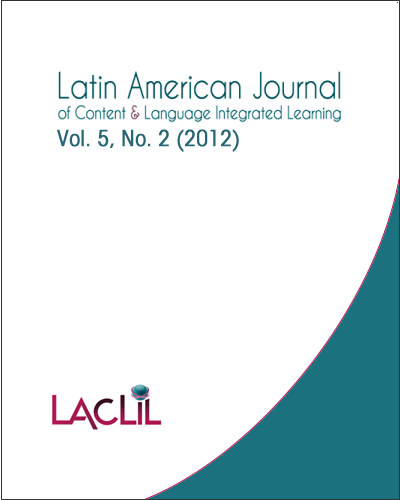Colombian teachers' questions about CLIL: What can teachers' questions tell us? (Part II)
DOI:
https://doi.org/10.5294/laclil.2012.5.2.6Keywords:
AICLE, Colombia, preguntas de los profesores.Abstract
The second part of this two-part paper starts with a review of the literature on teachers’ questions, going back 100 years, and finds an almost exclusive focus on teachers asking students questions in classrooms. To address this apparent oversight on the other kinds of questions teachers ask, for example to each other and to themselves, Colombian teachers were asked to write their questions about CLIL, at a workshop which was part of a new MA TESOL program. A total of 85 questions were written by approximately 80 language teachers from all over Colombia, 69 of which related to CLIL. These questions were divided into three groups or sets: CLIL in the Colombian Context; The Implementation of CLIL; and Fundamental Concepts of CLIL. These questions and these three categories are analyzed to see what developers of teacher development and CLIL training programs in Colombia can learn from such questions, and how they can inform the design of such programs.
Downloads
References
Aschner, M. J. (1961). Asking questions to trigger thinking. National Education Association (NEA) Journal, 50, 44-46.
Butler, Y. G. (2011). The implementation of communicative and task-based language teaching in the Asia-Pacific region. Annual Review of Applied Linguistics, 31, 36-57.
Brock, C. A. (1986). The effects of referential questions on ESL classroom discourse. TESOL Quarterly, 20(1), 47-59.
Corrales, K. & Maloof, C. (2009). Evaluating the effects of CBI on an English for medical students program. Latin American Journal of Content & Language Integrated Learning, 2(1), 15-23. doi:10.5294/laclil.2009.2.1.3
Coyle, D. (2008). CLIL – a pedagogical approach. In N. Van Deusen-Scholl & N. Hornberger (eds.), Encyclopedia of language and education (2nd ed.) (pp. 97-111). New York, NY: Springer.
Coyle, D. (2005) CLIL activity in the UK. In H. Krechel (Ed.), Mehrsprachiger Fachunterricht in Ländern Europas (pp. 79-88). Tubingen, Germany: Gunter Narr Verlag.
Curtis, A. (2012). Colombian teachers’ questions about CLIL: Hearing their voices in spite of “the mess” (Part I). Latin American Journal of Content & Language Integrated Learning, 5(1), 1-8. doi:10.5294/laclil.2012.5.1.1
Davis, O. L. & Tinsley, D. C. (1967). Cognitive questions revealed by questions asked by social studies student teachers. Peabody Journal of Education, 45(1), 21-26.
Flanders, N. (1951). Personal-social anxiety as a factor in experiential leaning situations. Journal of Educational Research, 45, 100-110.
French, P. & MacLure, M. (1981). Teachers’ questions, pupils’ answers: An investigation of questions and answers in the infant classroom. First Language, 2, 31-45.
Gall, M. D. (1970). The use of questions in teaching. Review of Educational Research, 40(5), 707-721.
Gilabert, R. (2009, April). The role of tasks in CLIL program development. Unpublished paper presented at the International Round Table on CLIL Programs at the Universitat Autònoma de Barcelona, Spain. Retrieved from http://ddd.uab.cat/pub/presentacions/2009/59866/GilabertTRI-CLIL_a2009eng.pdf
Jarvis, P. (1992). Reflective practice and nursing. Nurse Education Today, 12(3), 174-181.
Kao, S.-M., & Carkin, G. (2012, August). Don’t ask fake questions: Promoting authentic communication through drama. As We Speak: The Newsletter of the Speech, Pronunciation, and Listening Interest Section of TESOL. Retreived from http://newsmanager.commpartners.com/tesolsplis/issues/2012-08-16/5.html
Ladd, G. T. & Anderson, H. O. (1970). Determining levels of inquiry in teachers’ questions. Journal of Research in Science Teaching, 7(4), 395-400.
McDougald, J. S. (2009). The state of language and content instruction in Colombia. Latin American Journal of Content and Language Integrated Learning, 2(2). 44-48. doi:10.5294/laclil.2009.2.2.15
Moreno Alemay, P. (2008). English content-based approaches to teaching accounting. Latin American Journal of Content and Language Integrated Learning, 1(1), 26-34. doi:10.5294/laclil.2008.1.1.3
Nunn, R. (2009). The purposes of language teachers’ questions. International Review of Applied Linguistics in Language Teaching, 37(1), 23-42.
Otálora, B. (2009). CLIL research at Universidad de La Sabana in Colombia. Latin American Journal of Content and Language Integrated Learning, 2(1), 46-50. doi:10.5294/laclil.2009.2.1.7
Parr, M. (2011). Venturing into the unknown of ethnography: Reflexive questions to love and cautionary ethics to live by. Reflective Practice: International and Multidisciplinary Perspectives, 12(6), 803-815.
Prabhu. N. S. (1990). There is no one best method: Why? TESOL Quarterly, 24(2), 161-176.
Restrepo Guzman, J. O. (2008). Experiences in teaching finances in English. Latin American Journal of Content & Language Integrated Learning, 1(1), 35-42. doi:10.5294/laclil.2008.1.1.4
Russell, T. L. (1983). Analyzing arguments in science classroom discourse: can teachers’ questions distort scientific authority? Journal of Research in Science Teaching, 20(1), 27-45.
Shake, M. C., & Allington, R. L. Where do teachers’ questions come from? The Reading Teacher, 38(4), 432-438.
Stevens, R. (1912). The Question as a measure of efficiency in instruction: A critical study of classroom practice. New York, NY: Teachers College Columbia University Press.
Downloads
Published
How to Cite
Issue
Section
License
This Journal and its articles are published under the Creative Commons CC BY 4.0 DEED Attribution 4.0 International license. You are free to: Share — copy and redistribute the material in any medium or format for any purpose, even commercially. Adapt — remix, transform, and build upon the material for any purpose, even commercially. The license cannot revoke these freedoms as long as you follow the terms of the license.








